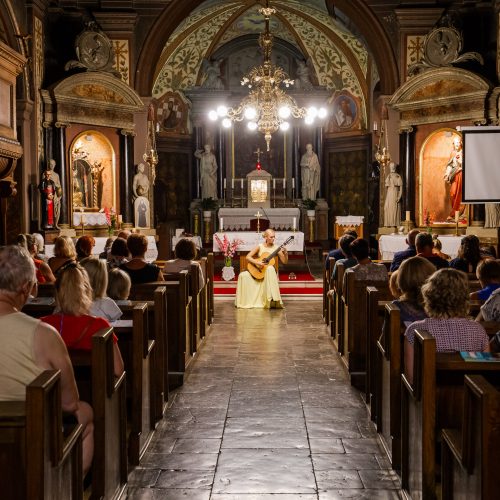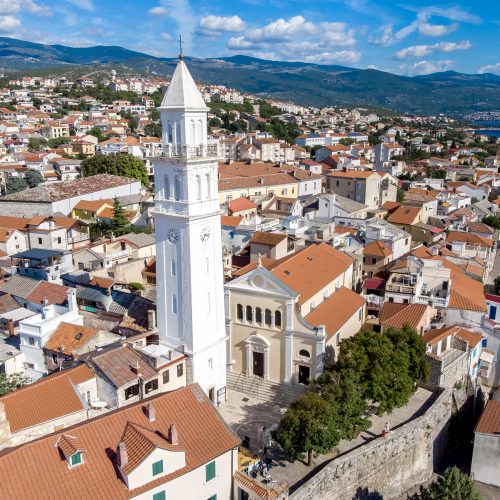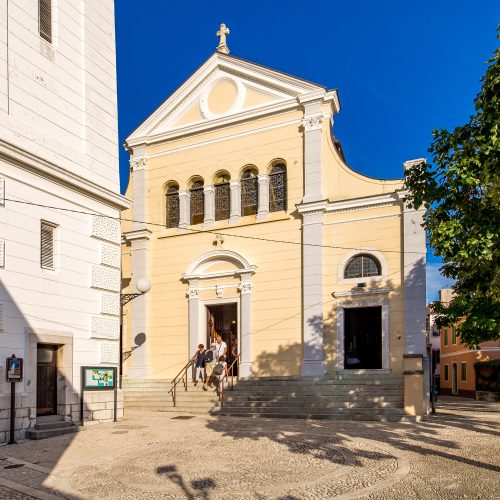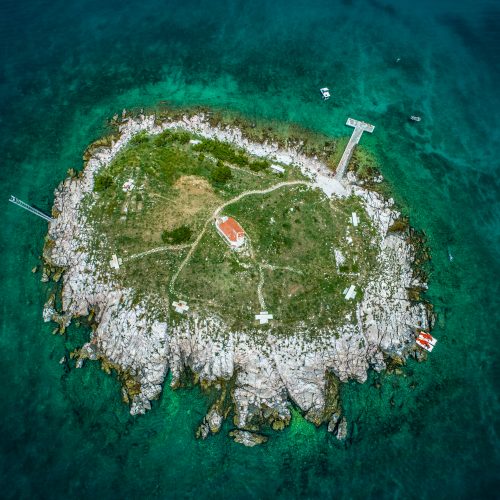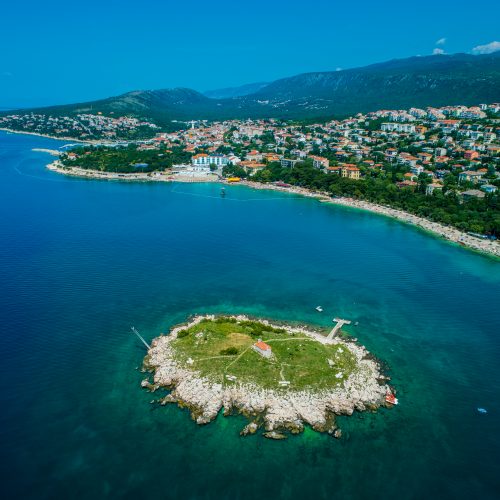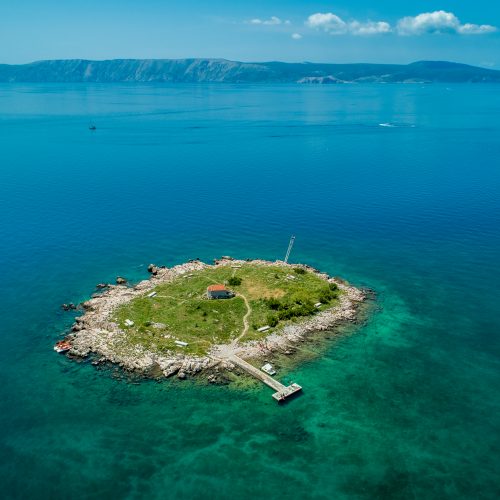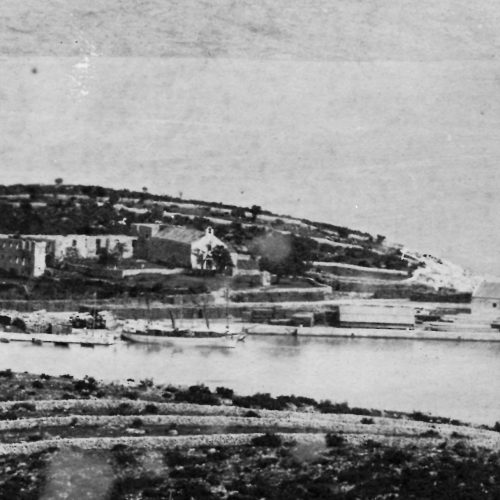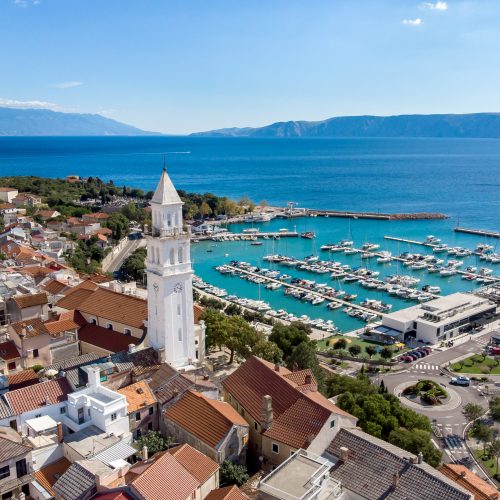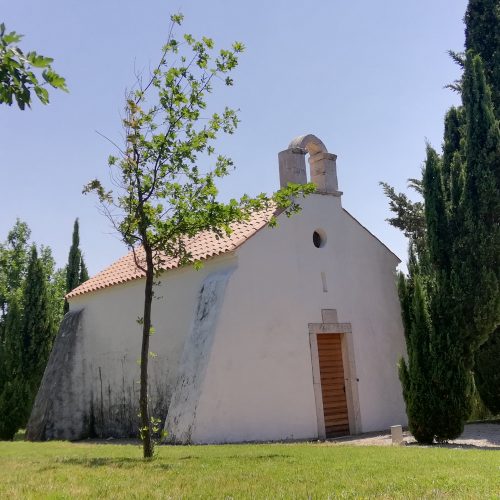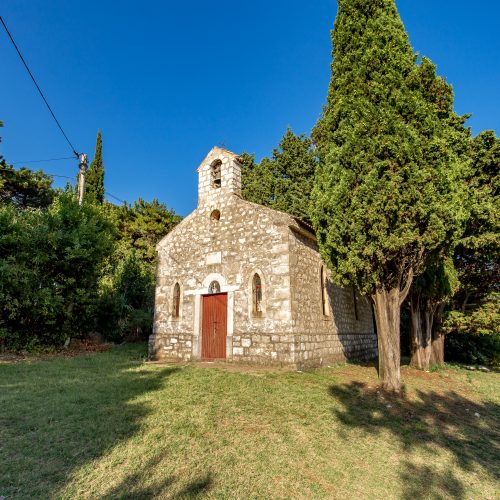Sacral heritage in the area of the town of Novi Vinodolski
The Church of St. Philip and James and the Church of St. Fabian and Sebastian
Church of St. Philip and James was built in the 14th century as a three-nave basilica. In the 18th century, the church was adapted to the baroque era, and at the beginning of the 20th century, the façade was renovated in the style of historicism. On the outer wall of the sanctuary, the year 1520 is engraved on two stones, with a combination of Arabic and Roman numerals, and then in Glagolitic script – most likely as a memorial to the restoration or rebuilding of the church, as the church itself is much older.
In front of the high altar there is the tomb of the Bishop of Modruš, Kristofor Dubrovčanin (Petančić), who escaped from Modruš with his chapter from the Ottomans and found refuge in Novi. He died there in 1499. The tombstone is made of marble and on it is a bishop’s figure with a Latin inscription. To the right of the altar is the tomb of Bishop Ivan Krstitelj Caballini, and to the left of Bishop Ivan Krstitelj Ježić. Above the door of the sacristy stands a relief tombstone of Canon Abbot Nikola Mrzljak, Vicar General of the Diocese of Modruš during the period of Bishop Ježić.
The altars were built in the 19th century in the neoclassical style. The church was decorated by master Peroš from Kastav.
Bell tower was in the front of the church, but it was demolished in 1909, and on the site of the demolished church of St. Fabian and Sebastian a new, 36-meter-high bell tower was built. The history of the little church is interesting. A stone slab has been preserved above the door of the demolished church (today in Zagreb at the Croatian History Museum). According to the folk tradition, it was built in 24 hours at the time of the plague, and St. Fabian and Sebastian are protectors against infectious diseases. Altar from 1656, decorated with carvings, is now located in the National Museum in the Novi Vinodolski Gallery.
For all information related to the schedule of Masses in the Parish Church of St. Philip and James in Novi Vinodolski, please contact: Parish Office of St. Philip and St. James / Phone: +385 (51) 244 205 / Address: Braće Radića 39, 51250 Novi Vinodolski.
Church of the Holy Trinity (Svete Trojice)
A single-nave Gothic church with a barrel-shaped vault over the sanctuary was built in the early 15th century. It is located in the Old Town, on the way from the Old Town to the port, not far from the Parish Palace. The altar of the church is the work of a local master, and its construction was instructed by the canon of Modruš, Antun Mažuranić, born in Novi (1687-1757). Since the middle of the eighties, after the renovation works, a collection of sacral art has been set up in it.
The collection is open for viewing in the summer months from 10:00. until 12:00 and from 20:00 to 23:00. For other months information are available in the Parish Office of St. Philip and St. James / Phone: +385 (51) 244 205 / Address: Braće Radića 39, 51250 Novi Vinodolski.
Church of St. Marino
On the island San Marino, eponymous church built in the 17th-18th century on the foundations of an older building is located. It was restored in 1818. A 4th century marble slab (stela) with an inscription in honour of the Roman Empress Helena, erected by the governor of Dalmatia Flavius Julius Rufinus Sarmentius, was found in its foundations. The plaque is kept today in the Archaeological Museum in Zagreb, with Roman money from tomb excavations near Hotel Lišanj.
Remains of the Church of the Blessed Virgin Mary
In 1462, on the peninsula near the port, duke Martin Frankapan Pobožni donated the Church of the Blessed Virgin Mary on Osap to the monks of the Order of St. Paul the Hermit, which he rebuilt. (Osap is the original name of the peninsula between the bays of Lišanj and Port, later called Fratarska Glavica or Glavica. The hill above Novi, today called Osap, was before called Veli Osap, Osep or Ospeč / Ospač). He also donated land to the Paulines for the construction of a monastery next to that church, in today’s cemetery in Novi.
In the documents on the history of the church and the Pauline monastery built next to it, there is a will of the parishioner Mihović from 1446, by which he leaves his property to the church. This is the proof that the church existed before that year.
The church was damaged in the earthquake of 1916 and collapsed in 1917. The remains of this church – the capitals of the supporting pillars, decorated with interesting carved depictions, are located in the lapidary of the National Museum and Gallery (on the ground floor of the Frankopan Castle).
Popis manjih crkvica i kapelica na području grada Novog Vinodolskog
- The Church of the Holy Cross (Kalvarija, Novi Vinodolski)
- Churches of St. Nicholas (Obala Petra Krešimira IV., Novi Vinodolski)
- The Church of St. Lucia (Novi Spa Hotels & Resort, Novi Vinodolski)
- The Church of St. John (Karst, Novi Vinodolski)
- The Church of St. Cosmas and Damian (Novljansko polje)
- The Church of Our Lady of Mount Carmel (Ledenice)
- The Church of St. Anthony (Donji Zagon)
- The Church of St. Magdalene (Povile)
- The Church of St. James (Krmpote)
- The Church of St. Elijah (Sibinj)
- The Chapel of St. Anthony (Park Sv. Antona, Korzo hrvatskih branitelja, Novi Vinodolski)
- The Chapel of the Holy Cross (Lokvica, Novi Vinodolski)
- The Chapel of the Holy Cross on Precrikva, next to the Diocese (Novi Vinodolski)
- The Chapel of the Mother of God in the castle wall (Braće Radića, Novi Vinodolski)
- The Chapel of St. Francis on the top of Pridol (Antona Mažuranića, Novi Vinodolski)
- The Chapel of St. Anthony, at the top of Stabljevica
- The Chapel of St. Roch (Vinodolska ulica, Novi Vinodolski)
- Glass chapel (village Omar, Krmpote)

